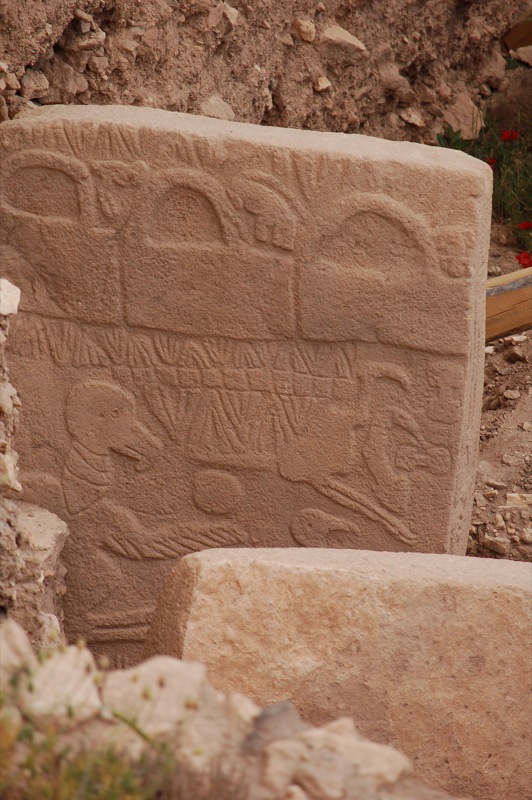Living in caves to get out of the cold is more than likely where mankind started down the road of masonry.
Core photo courtesy of Lonnie G. Thompson, The Ohio University
12,000 BP (before present) - Rapid Climate Change

Ice cores have revealed that global climate—long thought to change only very gradually—can shift with frightening speed, in some cases in a matter of years. As this graph shows, one such jump occurred about 12,000 years ago, as the last glacial period (the Pleistocene) was giving way to our current warm "interglacial" period (the Holocene). Suddenly, possibly in less than five years, average temperatures, which were slightly cooler than today's, plunged by about 27°F, returning the world to near-glacial conditions. (As the graph indicates, calcium levels tend to go up and snow accumulation down with temperature, which is estimated by comparing the ratio of oxygen isotopes in water—see "Temperature" in core at left.) The Younger Dryas, as this freak period is known, lasted about 1,300 years before it returned—just as abruptly—to the temperatures typical of the period immediately preceding it.
Data in graph taken from:
Alley, R.B., Meese, D., Shuman, C.A., Gow, A.J., Taylor, K., Ram, M., Waddington, E.D. and Mayewski, P.A., 1993, Abrupt increase in Greenland snow accumulation at the end of the Younger Dryas event, Nature 362, 527-529.
Grootes, P.M., Stuiver, M., White, J.W.C., Johnsen, S. and Jouzel, J., 1993, Comparison of oxygen isotope records from the GISP2 and GRIP Greenland ice cores, Nature 336, 552-554.
Mayewski, P.A., Meeker, L.D., Whitlow,S., Twickler, M.S., Morrison, M.C., Grootes, P.M., Bond, G.C., Alley, R.B., Meese, D.A., Gow, A.J., Taylor, K.C., Ram, M. and Wumkes, M., 1994, Changes in atmospheric circulation and ocean ice cover over the North Atlantic during the last 41,000 years, Science 263, 1747-1751.
Mayewski, P.A., Meeker, L.D., Twickler, M.S., Whitlow, S.I., Yang, Q. and Prentice, M., in press, 1997, Major Features and forcing of a high latitude Northern Hemisphere atmospheric circulation over the last 110,000 years, Journal of Geophysical Research.
What Came First - Temples or Tig?
Schmidt's argument is solipsistic, at best. You decide the oldest human structure that's ever been dug up is a temple, soConcluding that civilization sprang from religion and not the other way around is both intellectually dubious and socially irresponsible.
therefore the purpose of the earliest man-made structure must be worship. What if the buildings at Göbekli Tepe are not temples?Supposing we make the analogy that Mesolithic man was as a child. Certainly, he did not have the luxury of paying attention to much more than his most primal urges. Weather, sustenance, and predators took care of most of his brain-space, no matter how sophisticated his emotional and intellectual capacities were. In other words, he was like a child. What do most children do, once they're up and about and begin to have the freedom to bring their will to bear on theoutside world? Do they build Lego temples and solemnly gather together to pay homage to the great divine? They do not! They play with one another. They form essential human connections through apparently trivial interactions.

Göbekli Tepe Pictographs suggest a certain
sophistication, but not necessarily religious fervour. Image by Sean
Paul Kelley
sophistication, but not necessarily religious fervour. Image by Sean
Paul Kelley
In the case of the average 10th millenium BC bloke, those kinds of connections might well later save his life. Indeed, as humans, we're still hard-wired to seek out companionable agreement and respond to lack of social acceptance as a mortal threat, precisely because we haven't evolved very far from the men and women who needed every friend they could get when the woolly mammoth was upon them. Furthermore, anthropology tells us that humans like to compete in order to establish who carries the best genetic material in their eggs or sperm, and games therefore serve another function, which is to allow that ranking to occur. Göbekli Tepe looks to me just as much like an arena or entertainment space as it does a temple.
Concluding that civilization sprang from religion and not the other way around is both intellectually dubious and socially irresponsible. There are enough spurious facts out there for religious nutters to latch on to without Newsweek adding to the pile. The article reminds me of a review I once read by Rebecca West of a sociological book published in the 1950s that announced that adults were not especially emotionally attached to their children until the 19th century. As she wrily pointed out, if true, this must have caused much bewilderment among Shakespeare's contemporary audiences.
My suspicion is that, if the buildings at Göbekli Tepe are, indeed, temples - that is, buildings constructed purely for the purpose of ritualized acknowledgement of matters beyond the everyday - then it will turn out that the organized concentration of human habitation vastly predated them. Man, after all, invented God - not the other way around - and it seems highly unlikely that this was his first order of business.


